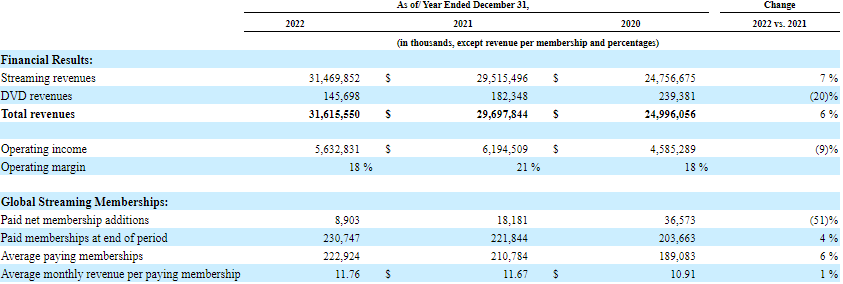Netflix, Inc. one of the world’s leading entertainment services, reported that it increased the number of subscribers, revenue and employees in 2022.
First and foremost, the company said it had approximately 231 million paying members worldwide at the end of last year, up 4.1% year-over-year.
In both 2021 and 2022, Netflix provided its services in more than 190 countries, where its customers enjoy TV series, movies and games in a wide variety of genres and languages.
Financial results of Netflix
Members can play, pause and resume to watch anything they want, anytime, anywhere, and can change their plans at any time.
Overall, Netflix’s core strategy is to grow its business on a global scale within the parameters of its operating margin target.
The company tries to encourage conversation around its content to further increase affiliate enjoyment, and continually improves its user interface to help its affiliates more easily choose content they find enjoyable.
Netflix
As of December 31, 2022, the company had approximately 12,800 full-time employees spread around the world in 65 countries. That workforce implies a growth of 13.3% over the 2021 close.
Of those, approximately 9,000 (70%) were located in the United States and Canada, 2,000 (16%) in Europe, the Middle East and Africa, 400 (3%) in Latin America and 1,400 (11%) in Asia-Pacific.
The company also has a number of employees dedicated to content production, some of whom work part-time or on a temporary basis, and whose numbers fluctuate throughout the year.
At the same time, its revenues totaled $31.616 billion, this is 6% more compared to 2021.
Netflix believes that a critical component of its success is its own company culture. This culture is often described as one of high performance, freedom and accountability.
Its goal is to attract and retain great people – representing a wide range of perspectives and skills – to work together as a dream team.
As Netflix has expanded its offices around the world, that company culture remains an important aspect of its operations.
It is also aware of cultural differences between and within regions. As such, fostering a culturally diverse, inclusive and equitable work environment is one of its main objectives.
![]()

